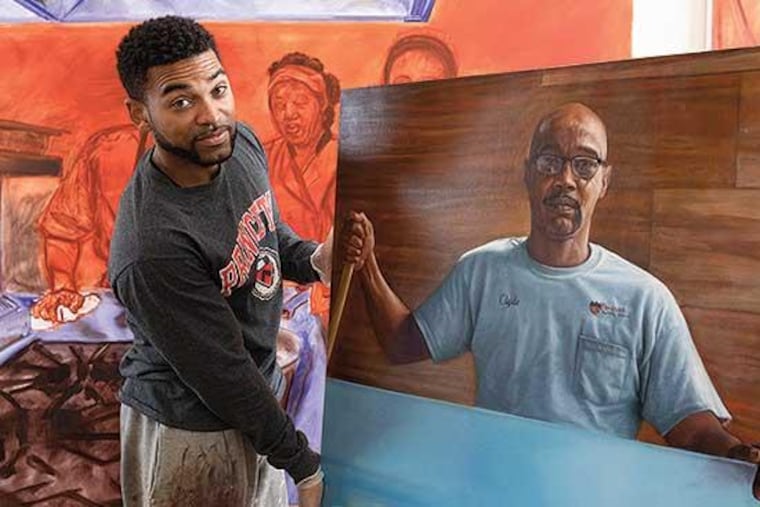Princeton adds portraits of blue-collar workers alongside those of college presidents and deans
The artist "wanted to make black people like my dad visible and put them in positions of power."

In the hallowed halls of Princeton University, Mario Moore noticed dozens of portraits of deans, donors, famous alumni, and college presidents in buildings across campus, a testament to the Ivy League institution’s illustrious past.
Moore, a 32-year-old artist who had observed the same thing at other universities, decided he could improve upon the mostly white, mostly male paintings that today’s diverse student bodies rarely look at in the daily rush to get to class.
What about the blue-collar workers, he wondered, who toiled behind the scenes to keep college campuses running?
“I wanted to honor them in some way — especially African Americans,” said Moore, who grew up in Detroit, where his father worked as an art museum security guard and his mother taught art classes at the College for Creative Studies.
“For a long time, I had this idea,” he said. “I wanted to make black people like my dad visible and put them in positions of power. In America, we put people in certain hierarchies and usually don’t consider blue-collar workers to be on the same level as other people around campus. It became important to me to change that.”
In summer 2017, Moore, who had been making a living creating artwork in Brooklyn, decided to apply for Princeton’s Hodder Fellowship — an annual $83,000 award given to several artists, writers, filmmakers, and other creative types, enabling them to pursue independent projects at the university for an academic year.
When Moore received a call notifying him he was a winner for the 2018-19 school year, he packed his bags and moved to Princeton, N.J., excited to put his dream on canvas. The end result — 10 paintings and 12 etchings of cooks, security guards, and groundskeepers at Princeton — has drawn accolades from artists, administrators, and students.
“Mario’s portraits capture beautifully the character and contributions of valued members of our campus community and bolster our broader efforts to ensure Princeton’s portraiture and iconography reflect the university’s values and diversity,” Princeton spokesperson Ben Chang said.
Moore’s exhibit, titled “The Work of Several Lifetimes,” was put on display for three months in the fall at the Princeton University Lewis Arts Center. The university subsequently bought five of the paintings to hang permanently.
“It’s been such a wonderful experience, but I’m mostly happy for the people I painted because they’re finally being recognized,” Moore said. “That was my entire goal. For them to be seen.”
Moore, the second oldest of five children, grew up doodling, he said, and was influenced by his mother, Sabrina Nelson, and her art students.
“When I was a kid, I would sit in on my mom’s classes and was always amazed to watch something created from nothing,” he said. “It was magical to me, and I knew that I wanted to be a part of that.”
Moore’s father, Kris Moore, was equally inspiring, he said, teaching him that he could achieve whatever he wanted if he was willing to work hard.
“My dad isn’t an artist, but he loves art and he showed me how much there was to learn from it,” he said. “Today, he works in the mail room at the Detroit Institute of Art, but when he was a security guard, he really came to know a lot about the paintings that surrounded him. I felt I’d probably find the same thing with the security people at Princeton.”
Moore, who earned a master’s degree in fine arts at Yale University, strolled around Princeton with his camera and notebook in the fall of 2018, looking for subjects to immortalize on canvas. Security guards, food service workers, and groundskeepers are among those he painted over a year.
“It’s the first project I’ve ever done that required me to walk up to strangers and get to know them,” he said. “I loved capturing those first moments and getting to know about their lives and experiences.”
To Moore, the project was larger than simply portraying the unique personalities of his subjects, he said.
“It was more about the idea of representing black figures and thinking about them in the history of paintings,” Moore said. “So many times, black people are in the background of paintings, serving Europeans. I wanted the people in my paintings to be powerful and prominent and look directly out at the viewer and draw them into the work. I wanted the viewer to see that gaze and directly share in that person’s story.”